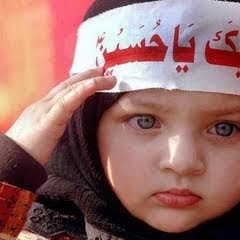The Shia
community is a Muslim minority sect and is differentiated from the majority
Sunni sect on the basis of a few Islamic principles.
What started
off as homage to the martyrs of Karbala 1400 years ago has now become a ritual
for us. For years, in almost every corner of the World, we celebrate the
Islamic month of Muharram with religious fervor to mourn and mark the death
anniversary of Hazrat Imam Hussein (A.S); the grandson of the Holy Prophet
(P.B.U.H) and his seventy one companions, who stood up for the true Islamic
spirit whose essence was forgotten in the tyrannical, extremist and barbaric
rule of Yazid Ibn Muawaiya. He and his followers finally laid their lives in
order to save the sanctity and purity of the religion of his grandfather: Islam.
For as back
as 720AD, amicable religious processions (jaloos) and Majlia -e- Aza (gathering
to mourn) are held in every corner of the country to pay tribute to Imam
Hussein (A.S) and his staunch companions, but, sadly since 2003 we; the Shias
in Pakistan have been a victim of ‘Sectarian violence’.
The first
major outbreak of the Shia-Sunni conflict (as it is primarily termed) took
place in the hustling bustling vicinity of Laiquat Bazaar, Quetta
(Baluchistan),In an Imambargah (Shia Mosque) that killed 123 people and wounded
many others.
From then
on, such attacks on the Shia community have become a norm and this heinous
crime marked the commencement of a new chapter in the history of Pakistan: ‘Sectarianism’.
Acts of
ghastliness and nefariousness against the Shias followed the tragedy of Quetta.
In October 2003, 12 Shia cadets were shot down in Quetta purely because of
their religion.
As many as
4,000 people are estimated to have been killed in Shia-Sunni sectarian fighting
in Pakistan between 1987–2007.And since 2008 "thousands of Shia" have
been killed by Sunni extremists according to the human rights group Human
Rights Watch. Among those blamed for the sectarian violence in the country are
mainly Sunni militant groups, such as the Lashkar-e-Jhangvi, Sipah-e-Sahaba,
Tehrik-i-Taliban Pakistan (affiliates of Al-Qaeda). Lashkar-e-Jhangvi "has
claimed responsibility for most attacks" on Shia according to Human Rights
Watch.
For the last
5 years Shias in the whole country no longer feel safe. On December 28, 2009, a
bomb exploded in the Ashura procession killing 40 people and wounding dozens.
In September 2010, a bomb exploded in Lahore followed by Quetta, causing 90
casualties and wounding 160 people.
Not only
have the Shias have been slaughtered ruthlessly in bomb-blasts, they; every now
and then have been victims of ‘target killing’. In June 2010, 7 intellectuals and bystanders were shot down in Karachi
(mostly Shias). On the inauspicious morning of 18th February 2013,
unidentified gunmen shot Dr Syed Ali Haider and his 11 year old son in the posh
vicinity of Gulberg, Lahore. Dr Syed was a leading a vitreo-retinal surgeon, who also worked in collaboration
with the Shaukat Khanum Memorial Trust Hospital.
But, the
most desolate tragedy of all: The multiple bomb-blasts in Quetta on the
unpropitious day of 10 January 2013, which killed 130 people and wounded 270. Protests
in Quetta by the city's Shia community erupted the day after the bombings, with
protesters and local Shia officials refusing to bury those killed until the
Pakistani army took control of security in the city. Protests also broke out
over the weekend of 12–13 January in Karachi, Lahore, Peshawar, Islamabad and
ten other smaller cities around the country. On 13 January, Prime Minister Raja
Pervez Ashraf visited protesters in Quetta and agreed to dismiss provincial
government officials, though he refused to implement military control in the
city.
Early on 14
January, he announced that Baluchistan Chief Minister Aslam Raisani and his
cabinet had been removed from their posts, with Zulfikar Ali Magsi appointed to
lead the provincial government. In response, Quetta Shias agreed to end their
protests and begin burials later in the day. Alas, all the attempts went in
vain as the government has not been successful in bringing an end to this
extermination against the Shias.
It has been
two months since the commencement of the year 2015 and the Shias have fallen
target inhumane act of bomb-blasts. No plea was heard when dozens cried in Chittya
Hattiyan ( Rawalpindi), no politician responded when the Imam Bargah Karbala-e-
Maula was targeted in Shairkpur (Sindh); No statement was issued by law
enforcement against when worshipers were slaughtered in Peshawar and neither
was yesterday’s bombing at a Shia Mosque was condemned by the elite!
When the
Army Public School massacre took place on 16th December 2014, within
a few days a National Action Plan (NAP) was drafted, all the political
differences were forgotten and the long held ban on executions was suddenly
lifted. For the past decade, thousands of Shias have been killed but the
government has not taken any course of action to deal with the issue of
sectarianism.
Are we not
the citizens of this country? Do we not have a right to live? Do we not
contribute to the welfare of this country?
The Shia
community shall be waiting for answers.





No comments:
Post a Comment